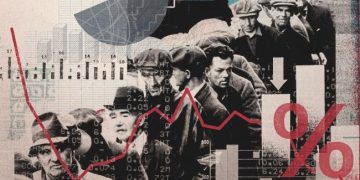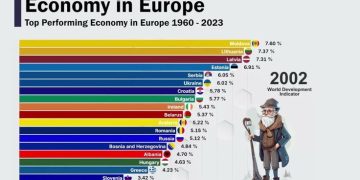Introduction
As we look ahead to 2025, global markets are poised to navigate through a variety of economic conditions. Understanding key economic indicators—such as Gross Domestic Product (GDP), unemployment rates, and the Consumer Price Index (CPI)—is essential for predicting market trends and crafting effective investment strategies. These indicators provide a snapshot of the health of economies worldwide and act as vital tools for investors, businesses, and policymakers. This article delves into these economic indicators, how they reflect current market trends, and how investors can use them to adjust their strategies for the upcoming years.
1. Understanding Key Economic Indicators
Gross Domestic Product (GDP)
GDP is one of the most widely used indicators to assess the economic performance of a country. It measures the total market value of all goods and services produced over a specific time period. GDP growth indicates a healthy, expanding economy, while a contraction suggests a recession or economic slowdown. For 2025, analysts are looking closely at how GDP growth rates are shaping up globally, especially in major economies like the U.S., China, and the European Union, which will have ripple effects on global markets.
Unemployment Rate
The unemployment rate is a crucial indicator of labor market health. It reflects the percentage of the workforce that is actively seeking employment but cannot find work. A low unemployment rate typically signals a strong economy, whereas high unemployment may indicate economic struggles. For 2025, shifts in unemployment rates, particularly in developed economies and emerging markets, will offer valuable insight into the potential for consumer spending, which is a key driver of economic growth.
Consumer Price Index (CPI)
The CPI measures the average change in prices paid by consumers for goods and services over time. It is a key indicator of inflation, which can have significant implications for consumer purchasing power, interest rates, and central bank policies. A high CPI suggests rising inflation, which can erode consumer purchasing power and lead to tighter monetary policy, while a low CPI indicates deflation or low inflation. Understanding CPI trends in 2025 will be crucial for predicting central bank actions and broader market movements.
Interest Rates
Interest rates, set by central banks like the U.S. Federal Reserve and the European Central Bank, play a central role in economic activity. Lower interest rates tend to stimulate borrowing and investment, while higher rates can dampen consumer spending and investment. The trajectory of interest rates, influenced by inflation and economic conditions, will significantly impact markets, particularly bond and equity markets.
Retail Sales and Consumer Confidence
Retail sales data provides insight into consumer spending patterns, which is a vital driver of economic growth. A rise in retail sales suggests that consumers are confident about their financial stability, while a drop may signal concerns about future economic conditions. Consumer confidence indices also offer a glimpse into how optimistic or pessimistic consumers are about the economy, affecting their purchasing behavior.

2. Current Data Reflecting Market Trends
As we approach 2025, several key global trends are emerging based on current economic data:
Economic Recovery and Growth
Many economies are showing signs of recovery post-pandemic, with GDP growth rates in major economies like the U.S., China, and the Eurozone indicating a return to growth, though at a slower pace than during the immediate post-pandemic rebound. The global economy is expected to grow, but the pace will likely be uneven across regions, with emerging markets and developed economies facing distinct challenges.
Inflationary Pressures
Inflation remains a key concern in many economies, driven by supply chain disruptions, energy prices, and labor market constraints. The CPI data for 2023 and 2024 suggests that inflationary pressures may persist into 2025, although central banks are actively taking steps to control it through monetary policy adjustments. While inflation is expected to moderate, certain sectors, such as energy and food, may continue to experience higher-than-usual price increases.
Labor Market Trends
In developed markets, unemployment rates have generally been falling, signaling a recovery in labor markets. However, some emerging markets continue to face higher levels of unemployment, with significant disparities in labor force participation rates. Job creation is a key factor in determining consumer confidence and spending power, both of which are essential for sustaining economic growth.
Investment Climate
The global investment climate in 2025 is likely to be influenced by a combination of factors, including interest rate policies, inflation levels, and geopolitical developments. Stock markets are expected to remain volatile, with sectors such as technology, green energy, and healthcare continuing to attract investor interest. At the same time, investors may be cautious in certain sectors that are more sensitive to inflation, such as traditional retail and manufacturing.
3. How Investors Can Adjust Strategies Based on Economic Indicators
Given the data available for 2025, investors must consider how best to position their portfolios to account for potential market fluctuations and opportunities. Below are strategies based on current economic trends and key indicators:
Diversify Across Asset Classes
Given the uncertainty surrounding interest rates and inflation, diversification will remain a key strategy. Investors should consider a mix of equities, bonds, and alternative investments. Equities in sectors such as technology, renewable energy, and healthcare may perform well, while bonds may be more sensitive to rising interest rates. Investors could also explore commodities, particularly those tied to inflation-sensitive sectors like energy and metals.
Focus on Inflation-Protected Assets
With inflation remaining a key concern, investors should look into inflation-protected securities such as Treasury Inflation-Protected Securities (TIPS) or real estate investment trusts (REITs), which tend to perform well in inflationary environments. Additionally, commodities like gold and oil may act as hedges against inflation, making them attractive additions to a well-rounded portfolio.
Stay Ahead of Central Bank Policies
Central banks’ responses to inflation and interest rate hikes will significantly influence market performance. Investors should monitor central bank decisions closely, as rising interest rates may lead to reduced liquidity and impact stock market valuations. Understanding the trajectory of interest rates can help investors make informed decisions about bond investments and equity allocations.
Invest in Growth Sectors
As economies recover, sectors that are aligned with long-term growth trends, such as clean energy, digital transformation, and healthcare, are likely to continue outperforming. These sectors benefit from both economic recovery and the global shift toward sustainability and technological advancement. Investors should prioritize stocks and ETFs in these areas to capitalize on long-term growth.
4. Conclusion
As we move into 2025, the global economic landscape presents both opportunities and challenges for investors. Key economic indicators, including GDP growth, unemployment rates, and CPI, provide valuable insights into the health of global markets and the potential risks and rewards for investors. By staying informed about these indicators and adjusting their investment strategies accordingly, investors can navigate the complex market dynamics of 2025 and position themselves for success in an uncertain global economy.




































